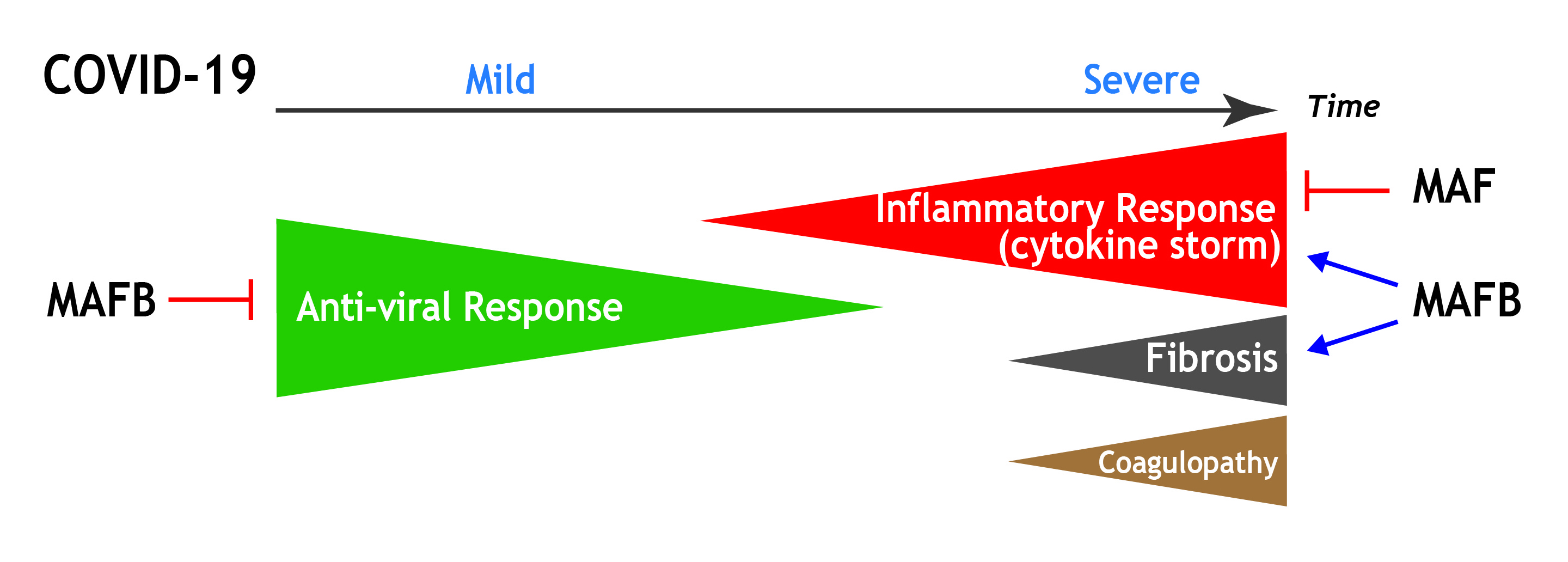
A work published in Frontiers in Immunology by the Myeloid Cell Biology group at Centro de Investigaciones Biológicas Margarita Salas (CIB-CSIC) has led to hypothesize a key role for the macrophage transcription factors MAFB and MAF in the development of severe COVID-19. The study proposes that a high MAFB/MAF expression ratio in lung macrophages could be a suitable biomarker for disease progression, and that therapies directed towards inverting the above ratio might be effective to combat the most severe forms of COVID-19.
It is firmly established that macrophages lie at the center of the COVID-19 pathogenesis, and that deregulated activation of pulmonary macrophages in response to SARS-CoV-2 infection results in lung injury through exacerbated cytokine and pro-fibrotic responses.
The recent elucidation of the transcriptional profiles of pathogenic FCN1+ (pro-inflammatory and monocyte derived) and SPP1+ (pro-fibrotic) lung macrophage subsets in severe COVID-19, combined with results from the laboratory at the CIB Margarita Salas on the factors that drive human macrophage polarization and on bioinformatic analysis of data derived from gene expression experiments, have led the authors to propose that the transcription factors MAFB and MAF significantly contribute to the response of macrophages to SARS-CoV-2 infection by shaping the gene and phenotypic profiles of the pathogenic FCN1+ and SPP1+ macrophage subsets. More specifically, the MAFB function as a negative regulator for interferon (IFN) production, and its ability to shape the transcriptome of pro-fibrotic SPP1+ lung macrophages, suggest its participation in the defective type I IFN production and the pro-fibrotic response that characterize severe COVID-19. Regarding MAF, the results from the CIB group indicating its ability to limit the expression of pro-inflammatory cytokines and chemokines, and its negative effect on the acquisition of the transcriptome of FCN1+ pulmonary macrophages, suggest its involvement in triggering the “cytokine storm”, a major trademark of COVID-19.
Based on those findings, the article by Vega et al. proposes that a high MAFB/MAF expression ratio in lung macrophages could serve as an accurate diagnostic tool for COVID-19 severity, and that therapies directed to simultaneously silencing MAFB and overexpressing MAF in pulmonary macrophages might constitute suitable strategies to combat COVID-19, by their effects on reversing the exacerbated inflammatory and profibrotic responses that characterize severe COVID-19.
The hypothesis here presented has provided the theoretical/experimental basis to approach some of the objectives included in a proposal to the BBVA Foundation by the Myeloid Cell Biology group which has been recently awarded within the frame of the Grants to SARS-CoV-2 and COVID-19 Scientific Research Teams in Biomedicine.
Reference: MAFB and MAF transcription factors as macrophage checkpoints for COVID-19 severity. Miguel A. Vega, Miriam Simón-Fuentes, Arturo González de la Aleja, Concha Nieto, María Colmenares, Cristina Herrero, Ángeles Domínguez-Soto and Ángel L. Corbí. Frontiers in Immunology, 2020, DOI: 10.3389/fimmu.2020.603507

